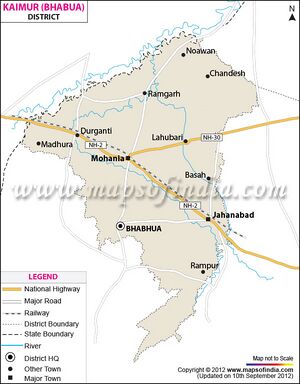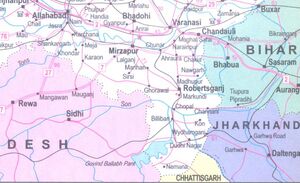Bhabhua


Bhabhua (भभुआ) is a city in Kaimur district in Bihar, India. The district headquarter is located at Bhabua. Kaimur district is a part of Patna division.
Variants
Location
It is the westernmost district of Bihar, western point of Bihar called Chand is situated on the Bhabua-Chandauli road.
Jat clans
History
Kaimur district was established in March 1991. It was sectioned off from the Rohtas district. The earliest evidence of human habitation in the district consists of rock paintings in the Lehda forest that date to around 20,000 years ago. In June 2012, erotic Pala sculptures were excavated in the village of Baidyanath.[1]
Administrative Divisions
Sub Divisions: Mohania subdivision, Bhabua subdivision
Blocks: Bhabua, Ramgarh, Mohania, Durgawati, Adhaura, Bhagwanpur, Chand, Chainpur, Kudra, Rampur, Nuawon
Rivers
Durgavati River, Karmanasa River, Kudra River. Waterfall: Karkat Waterfall, Telhar.
The Kaimur Range and Rohtas Plateau cover the southern part of this district.
Mundesvari Temple

Mundesvari Temple stands on the summit of an isolated hill about 603 feet high at village Ramgarh, seven miles south-west of Bhabua. Mundesvari temple is the earliest specimen of the Nagara type of temple architecture available in Bihar. It is unfortunate that, although a distinct style of temple architecture, known as the Nagara type, was evolved in Magadha with its centre at Pataliputra, specimens of it even in Bihar are very rare. This gives an added importance to the Mundesvari temple, although much of the structure has crumbled down. From the point of view of the age of temples, this is the oldest in Bihar. An inscription in two broken pieces was found and has been interpreted by some, as discussed later, to identify the origin of the temple to the year 635 A.D. The inscription refers to Udayasena as the ruling chief and records various donations to Mandalesvara.
There is clear impress of the Gupta style on the carvings. In the centre is a Siva Linga, with four human faces on the phallus. The image called Mundesvari, or the goddess Munda, is an armed female having many hands and riding on a buffalo: it probably represents the wife of Mahisasur, a celebrated antagonist of Parvati the hair and ears evidently resemble those of the Buddhas: it is placed in the door, behind which is a small cavity without any external opening.
It is very fortunate that Francis Buchanan, in his account of the District of Shahabad in 1812-13, has left a description of the Mundesvari temple and the tradition associated with it. Buchanan's account is of particular importance because of the tradition that was mentioned to him regarding the temple. It is as follows:
"There was a certain Munda, whom people pretty generally call a Chero Raja; but the pandit of the survey says that he was a Daitya, who had a brother named Chanda, and both lived in the golden age. These brothers who, according to the Markandeya Purana, were the chief military officers (senaptis) of Sumbha and Nisumbha, two great infidel (Daitya) kings, were killed by Parvati, who on that account is called Chamunda, a title, it is said, composed of the two infidels' names.
It is further said that the proper name of Chayanpur is Chanupur derived from one of the brothers who resided there, while a small temple named Mundesvari, and situated on a hill about five miles east from Chayanpur, was built by the Daitya Munda. If there is any foundation for the Puranic legend, it may refer to some exploits in the Indian warfare of Semiramis; but from the appearance of the ruins I have little doubt not only of the truth of the common report of Munda Raja having been a Chero but that he was some small chief, who retained a dependent principality long after his nation had ceased to possess the imperial dignity.
The town where Munda resided is called Garohat, and was situated on the banks of the Katane, just in the eastern mouth of a valley formed between the great mass and the detached range of hills west from Bhagwanpur. The whole of this valley was originally called Mukeri Kho; but that name has of late been restricted to a large recess towards its east end, down which the Katane flows.
The situation was judicially chosen for the residence of a person such as I suppose Munda to have been; as it is not only in a very rich country, but has behind it recesses in the mountains that are capable of defence by a small force; and even in case of defeat, the mountains afford a secure means of escape...."
Source - http://www.hindubooks.org/temples/bihar/mundesvari/index.htm
Mundeshvari Inscription of Udayasena The Harsha Year 30 (635 AD)
This inscription, was discovered among the debris which had accumulated around the temple of Mundesvari (मुण्डेश्वरी) in the Bhabua subdivision of the Shahabad district. The inscription was finally brought to the Indian Museum in the beginning of 1904.
The inscription records a grant of two prasthas of rice and a pala of oil to the god Mandaleshwara by a kulapati named Bhāgudalana. It is dated in the year 30 in the reign of the Mahasamanta, Mahapratihara, Maharaja, Udayasena, who is not known from other sources.
Judging from, the affinity of the characters of this inscription with those of the years 34 and 39 from Nepal, 6th era is most probably that established by Harshavardhana.
Text of Mundeshvari Inscription of Udayasena
1. Om Samba(mva)tsare trinsati[tame] Kārttika-divase dvāvinsatime
2. asminsamba(mva)tsara-māsa[diva]sa-purvvayam shri-Mahāsamanta-
3. Mahāpratihāra-Mahāraj-[Oda]yasena-rajya kulapati-Bhagudalana-
4. s=sa devanikayom danda[nā]yaka-Gomibhaṭena prārtthayitva
5. mātapittror=atmanas=cha pu[nya]bhivriddhaye Vinitesvara-maṭhasamā-
6. vesam maṭhām=tat=karākaram [Sri-]Narāyana-devakulasya
7. sri-Mandalesvara-svami-[pādā]ya koshthikātah a-chandr-ārkka-sama-
8. kāliyam=akshayam prati[dinām] naivedyarttham taṇḍula-prastha-dvayam
9. dipa-taila-palasya ch=O[pani]bandhah kāritah sri-Mandalesvara
10. svami-pādānām vichchhi[tti-vi]srānt-tantra-sādhāraṇam panchasātām
11. dinaranam goba . . . ja-bhaktādy-upakaraṇani
12. devanikayasya datta[m=etad=e]vam viditvā yathākal-ādhyā [sibhij-
13. r=apovanikair=vvā ya[thani]baddhasya vighāto na kā[rya]
14. evam=abhisravito yo[=nyathā]kuryāt=sa mahapatakais sa[ha]
15 [nara]ke vaset evam . . . vadharaṇaya madhya
16 ..... bhāka . , , tam=iti [Ukta[n=cha]
17 ....... yatnad=raksha Yudhishthira
18 .....
Translation
Hail. In the year 30, on the twenty-second day of Karttika, the the above mentioned year, month and day, in the reign of the great feudatory, the Mahapratihara the Maharaja [Uda]yasena, the Kulapati Bhagudalana, having applied to the Council of gods through the dandanayaka Gomibhaṭa built this maṭha of the davakula of Narayana, to increase the merit of his father and mother and of his own self, near the temple of Vintesvara. For the lord Mandalesvara provision has been made every day, as long as the Sun and Moon last everlastingly, to provide two prasthas of rice for the votive offering a pala of oil for the lamp from the treasury. Fifty dinaras current up to the frontiers.... of the Lord Mandalevara- ..... wit h rice and other ingredients. Knowing it to be a gift of council of gods, the merchants who trade on the waters(?) and who arrive on the proper time should not hinder this arrangement. Having heard this, whoever contrary shall live in hell with great sins .... O! Yudhishthira, presrve with care ....... preservation is preferable to gifts.
भबुआ
विजयेन्द्र कुमार माथुर[2] ने लेख किया है ...भबुआ (AS, p.660), जिला कैमूर, बिहार में स्थित है. इस स्थान पर सातवीं सदी के पूर्वार्ध में बना हुआ, मुंडेश्वरी देवी का मंदिर उत्तरी भारत के प्राचीनतम मंदिरों में से है. इस मंदिर के प्रवेश द्वार की पत्थर की चौखट के पट्टों पर देवताओं विशेषकर गंगा-यमुना की मूर्तियां अंकित हैं जो गुप्त-मंदिरों के वास्तु का प्रिय विषय था. इस मंदिर की खोज 1905-6 में डॉ. ब्लॉक ने की थी. एक दानलेख में जो यहाँ मिला है, महा सामंत उदयसेन के शासनकाल में भागुदलन नामक व्यक्ति के कुछ दानों का वर्णन है. इसमें विनीतेश्वर के मंदिर के निकट एक मठ के बनवाए जाने तथा मंडलेश्वर (=मुंडेश्वरी) विष्णु के मंदिर के लिए दिए हुए दान का विवरण है. पाल नरेशों के शासन काल (800-1200 ई.) में इस मंदिर में कई परिवर्तन किए गए थे. मुंडेश्वरी का मंदिर षट्कोण आधार पर बना है. ऐसा नक्शा भारत में अन्य प्राचीन मंदिरों में अन्यत्र नहीं दिखाई देता. भूमरा के मंदिर की भांति ही इसकी कुर्सी के आधार पर गोल चौड़ी उभरी हुई पट्टियां बनी हैं और कीर्तिमुख सिंहों के मुखों में माला धारण किए हुए मूर्तियां निर्मित हैं. प्रवेश द्वार की चौखट पर सूक्ष्म तक्षण के साथ मानव-मूर्तियों का भी अंकन है. गुप्त-कालीन मंदिरों की कला-परंपरा के अनुकूल ही इस मंदिर में भी सुघड़ चैत्य-वातायनों को धारण करने वाले स्तंभ हैं जिन पर अंकित मूर्तिकारी बड़ी मनोरम जान पड़ती है.

